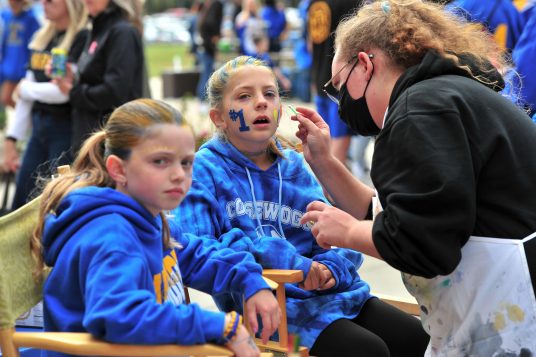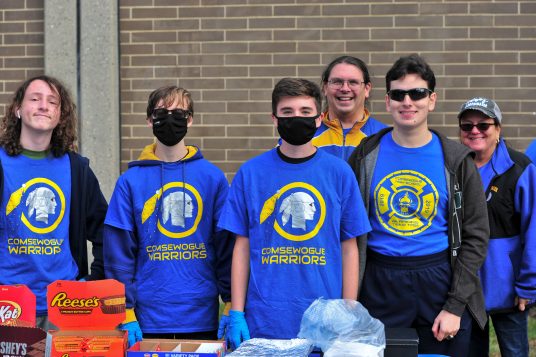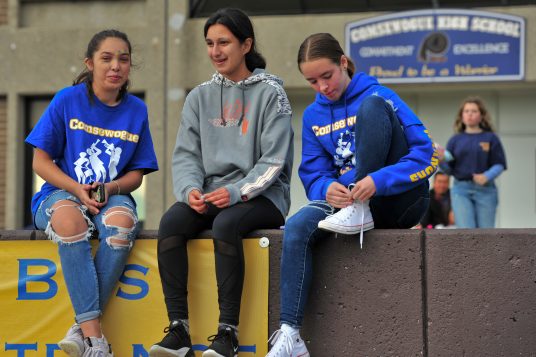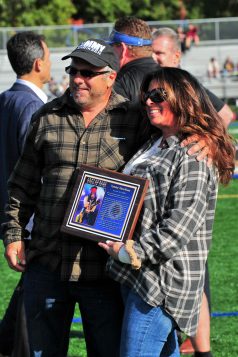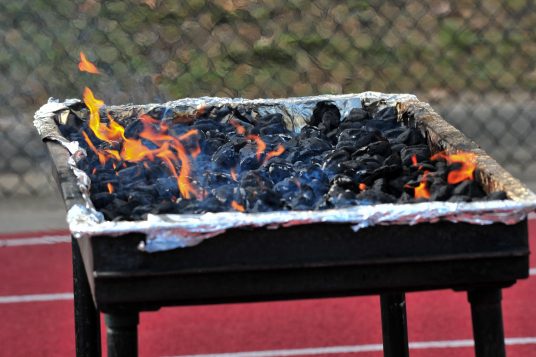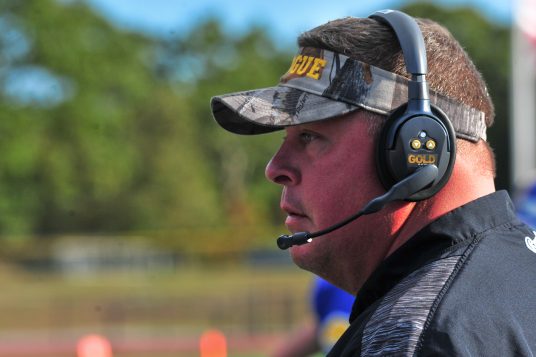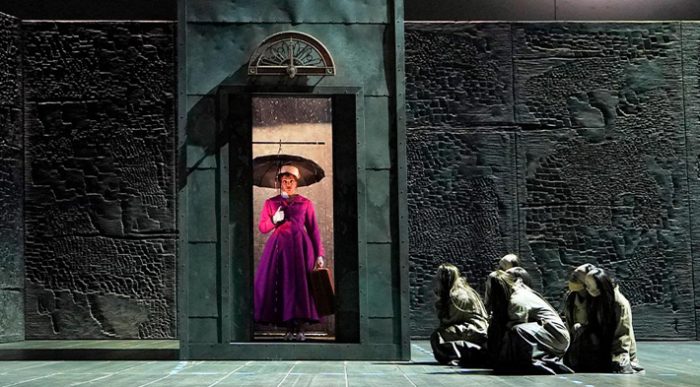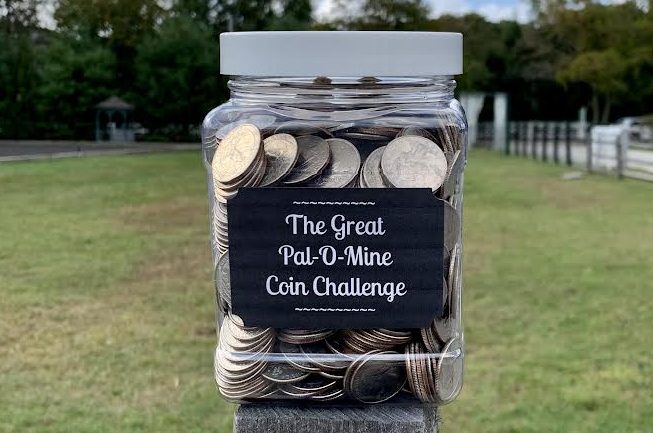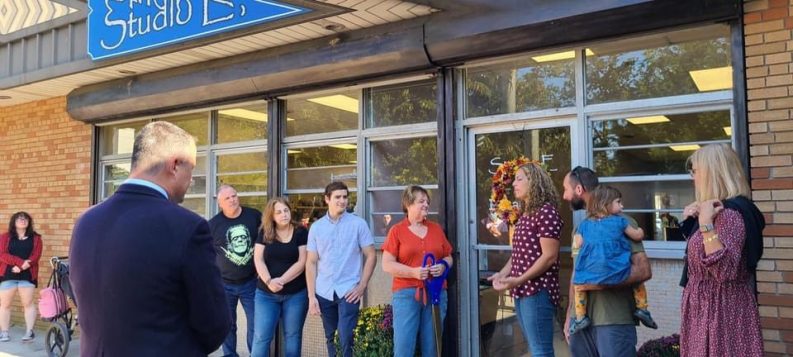Yearly Archives: 2021
Stunning Waterfront Colonial In Nissequogue!
For more information click here
Kingsmen rain on Warrior homecoming game

The Kingsmen of Kings Park raided Warrior nation and put a damper on Comsewogue’s homecoming football game Oct 23 where the Warriors struggled to find traction. Kings Park quarterback Jonathon Borkowski punched in for the score on a keeper in the final minute of the opening quarter and followed it up four minutes later with 10-yard touchdown run to put his team out front 14-0.
On Comsewogue’s ensuing possession Kings Park cornerback Kyle Weeks stepped in front of Brady Shannon’s shovel pass for a pick six that covered 41 yards. Kings Park senior Mert Duman whose foot was perfect on the day made it 21-0 at the half. Jonathan Borkowski’s 10-yard run found the endzone midway through the 3rd quarter for the 28-0 lead. Kings Park senior Nick Laviano broke free for a 60-yard run early in the 4th for a 35-0 advantage. Shannon the senior quarterback would avoid the shutout in the closing minutes with an 11-yard run for the score and with Josh Carrolls kick concluded the game for your 35-7 final.
The win lifts Kings Park to 5-1 in Div-III while the loss drops the Warriors to 2-5. Comsewogue concludes their 2021 campaign when they retake the field Oct 29 hosting Hills West. Kings Park is also back in action on Oct 29 with a road game against East Islip. Kickoff for both games is 6 p.m.
— All photos by Bill Landon















Islanders fans votes are in, the third New York Islanders’ Puppy With a Purpose® will be named ‘Monte’
New York Islanders partner with Guide Dog Foundation to raise and train Monte
The Guide Dog Foundation, a New York based-non-profit that provides guide dogs to individuals who are blind or visually impaired, is thrilled to partner again with the New York Islanders in their “Puppy with a Purpose” program supported by Canidae. In celebration of the Foundation’s 75th anniversary, the Islanders will train future guide dog “Monte.”
Monte, a 9-week-old, male black Labrador puppy, made his debut with the Islanders on October 11th during the team’s fifth annual ‘Pucks and Paws 2022’ calendar photoshoot. The calendar, benefitting the Guide Dog Foundation and supported by Canidae, will go on sale in time for “Black Friday” shopping. Calendars will be available for purchase online via the Islanders website and at home games.
Monte, a black Labrador, will undergo basic training and socialization with the Islanders’ staff, fans and public for the next 14-16 months. The Islanders will host Monte at community events and select home games to assist in raising him to be a confident and calm future guide dog. Fans can follow Monte on Instagram at @NYIslesPup to stay up to date on his training and local appearances.
Following his puppy raising, Monte will return to the Guide Dog Foundation campus in Smithtown, NY to begin his formal guide dog training. Concluding his training, Monte will be matched at no cost with an individual who is blind or visually impaired.
“It’s an absolute pleasure to partner again with our friends at the New York Islanders to help celebrate the Guide Dog Foundation’s 75th anniversary,” John Miller, President and CEO, Guide Dog Foundation said. “What’s better than to be here in our hometown on Long Island to continue this partnership for the third time with the New York Islanders? The partnership is outstanding. Ownership, coaches, the team, and fans, all have embraced the program and we couldn’t be any happier to continue this life changing program with the team.”
Monte is the third dog the Islanders has partnered with the Smithtown based organization to raise and train. In June, the Islanders and America’s VetDogs, sister organization to the Guide Dog Foundation, placed service dog in training Tori with retired U.S. Navy Veteran and FDNY Lieutenant Chris Roberto. The Islanders first dog Radar was successfully placed as a guide dog in August 2020 with gold medalist Paralympian swimmer and Long Island native Anastasia Pagonis.
It costs over $50,000 to breed, raise, train, and place one assistance dog; however, all of the VetDogs’ services are provided at no charge to the individual. Funding comes from the generosity of individuals, corporations, and service and fraternal clubs.
ABOUT GUIDE DOG FOUNDATION
For 75 years, the Guide Dog Foundation for the Blind, Inc. (www.GuideDog.org), has trained and placed guide and service dogs to provide independence, enhanced mobility, and companionship to people who are blind, have low vision, or have other special needs. The Guide Dog Foundation is a 501(c)(3) not-for-profit organization serving clients from across the United States and Canada. The Foundation relies on contributions from generous individuals, corporations, service clubs, and foundations to fund its mission to serve people with disabilities.
Staller Center presents an evening of opera Oct. 28

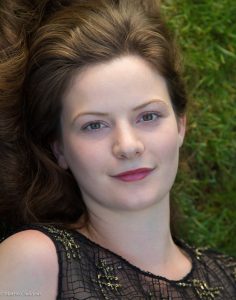
Stony Brook University’s Staller Center for the Arts, 100 Nicolls Road, Stony Brook presents a lecture and recital by award-winning composer Matthew Aucoin titled “Primal Loss: Four Hundred Years of Orpheus and Eurydice in Opera” in the Recital Hall on Thursday, Oct. 28 from 8 to 9:30 p.m. Aucoin will discuss his opera Eurydice premiering at the Metropolitan Opera in November 2021, the influences of playwright Sarah Ruhl and the history of Orphic operas. Soprano Liv Redpath will perform selections from the play. Free.
Proof of vaccine or valid exemption required for all attendees.
See stallercenter.com/contact/Covid for details.
Sponsored by the English Department, the Office of the Provost, the Music Department, the Humanities Institute at Stony Brook, The Hellenic Center, the Graduate Student Organization, the Women’s Gender, and Sexuality Studies Department, the Walt Whitman Birthplace, and the Walt Whitman Initiative.
For more information, www.stonybrook.edu/hisb
Pal-O-Mine Equestrian kicks off coin challenge fundraiser
Corporate sponsor sought to provide matching funds
Pal-O-Mine Equestrian, Inc., a private, not for profit organization providing a comprehensive therapeutic equine program using horses to facilitate growth, learning and healing for children and adults with disabilities, is asking Long Islanders to participate in the Great Pal-O-Mine Coin Challenge to help raise funds for its vital programs. The challenge will run through December 23rd with prizes awarded to the individuals bringing in the most coins.
Here’s how it works. School students, employees, volunteers, staff and the general public can pick up designated coin jars at Pal-O-Mine located at 829 Old Nichols Road, Islandia. Then, collect change in all denominations. Once their jar is filled, it can be returned to Pal-O-Mine where it will be weighed and entered into the heaviest jar competition. There will be two opportunities to win special Pal-O-Mine holiday baskets. A Harvest basket will be awarded on November 24th and a Winter basket will be awarded on December 23rd.
At this time Pal-O-Mine is looking for a corporate sponsor to provide a minimum donation of $5,000 to serve as a matching gift to the funds raised through the Great Pal-O-Mine Coin Challenge. If you are interested, call Pal-O-Mine at 631.348-1389. All the coins collected by Pal-O-Mine will be turned into the bank to help meet the coin shortage.
Long Islanders who wish to participate in the Great Pal-O-Mine Coin Challenge and would like additional information or to pick up their designated coin jar, contact Pal-O-Mine at: 631-348-1389.
About Pal-O-Mine
Founded in 1995 by Lisa Gatti, Pal-O-Mine is a private, not for profit organization providing a comprehensive therapeutic equine program using horses to facilitate growth, learning and healing for children and adults with disabilities, as well as those who have been abused or neglected, veterans and the economically compromised. Pal-O-Mine offers a broad range of programs many of which involve the organization’s herd of therapy horses and livestock. Pal-O-Mine relies on grants and contributions from private citizens, foundations and businesses to help raise funds. For more information on Pal-O-Mine, visit:www.pal-o-mine.org
Rocky Point Sound Beach Chamber hosts ribbon cutting for Studio E
The Rocky Point Sound Beach Chamber of Commerce hosted a ribbon cutting celebration for Studio E Art Classes, located at 77 Broadway in Rocky Point, on Oct. 15. The chamber welcomed the studio’s new owner, Kathleen Grancher, and thanked the previous owners, Michelle and Stelios Stylianou, for being pillars in our community.
“From science to art, Kathy has spent the past 30 years working in Clinical Research. The gift of pottery lessons with a master potter 25 years ago furthered the love of art and clay. Now after retiring Kathy has embarked on a new adventure as owner of Studio E Art Classes. She is thrilled to have the opportunity of providing a welcoming environment for all to find joy in creativity,” read a press release sent by the chamber.
The celebration was attended by Gary Pollakusky, RPSB Chamber founder and President, Nichaldeep Parhar, RPSB Chamber Membership Director, Charles Todaro, RPSB Chamber Treasurer, Brookhaven Town Councilwoman Jane Bonner, NYS Assemblywoman Jodi Giglio, Chad Lennon representing NYS Senator Anthony Palumbo, family and friends.
Studio E has a dedicated team of teachers and visiting artists who offer weekly programs for children, teens and adults and also offer birthday parties and summer camps. For more information, call 631-744-4001 or visit www.studioeartclass.com.
Editorial: Fall cleanups
Over the summer, dozens of nonprofits and organizations hosted beach and park cleanups across Long Island.
People came together with their trash bags in hand to pick up debris and trash. Families made days out of it, grabbing dinner afterward with the kids. Couples turned it into a bonding experience.
While it’s inspirational and helpful for members of the community to work together to clean up the communities in which we live, shouldn’t the town government take the lead with these efforts?
To that end, the road along Route 25A in Setauket has eyesores that detract from the beauty and safety of our community, including several dead trees, overgrown gardens, leaves and debris. Street lights that protect pedestrians and help drivers navigate the area are dimming, making them less useful as we approach days with less sunlight.
Long Islanders receive and appreciate the return on investment from their taxes, particularly when roads are cleared after a storm or when children receive excellent educations from public schools. Given the tax bill, however, shouldn’t the town be able to use some of that money for upkeep?
The community doesn’t police itself and shouldn’t need to clean up accumulating messes or detritus from trees or other vegetative growth. Residents can, and should, dispose of their own trash. Landlords should also take responsibility for the space outside their residences.
As for those public places the village, town or county oversees, those responsible for upkeep on those properties should step up their game.
We appreciate the work the municipalities do, particularly under difficult circumstances and, at times, with limited resources. We are also grateful to the go-getters whose efforts enhance the beauty of the communities we share.
At the same time, we need our elected officials and people with authority to take action to remove these dead trees, fix dim lights and remove garbage by the side of the road. The effort they put in now will save money and aggravation later, as well as improve the local environment.
SBU’s Peng Zhang scores 5 mln from the DOE for AI-driven energy research
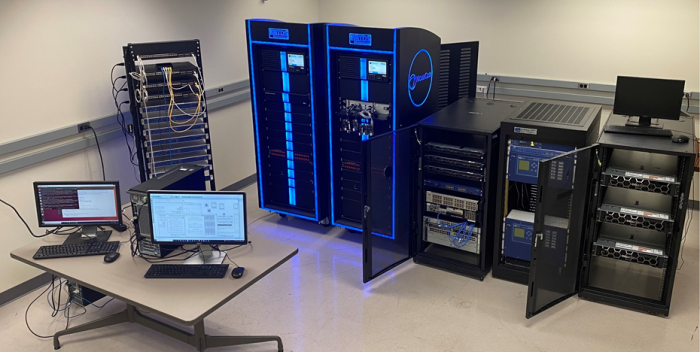
By Daniel Dunaief
The Department of Energy is energized by the possibility of developing and enhancing microgrids.
What are microgrids? They are autonomous local power systems that have small, independent and often decentralized energy sources. Often, they use renewable energy, like wind or solar power, although some use natural gas or diesel.
The DOE’s dedication to developing these microgrids may cut costs, create efficiencies and enhance energy reliability.

Peng Zhang, SUNY Empire Innovation Professor in the Department of Electrical and Computer Engineering at Stony Brook University, is leading a diverse team of researchers and industry experts who received $5 million of a $50 million investment the DOE recently made to developing, enhancing and improving microgrid technology.
Bringing together these energy experts, Zhang hopes to use artificial intelligence to create a usable, reliable and efficient source of energy, particularly during periods of power outages or disruption to the main source of energy.
“The traditional microgrid operation is based on models and human operators,” Zhang said. “We developed this data-driven or AI-based approach.”
Artificial intelligence can enhance the safety and reliability of microgrids that can receive and transmit power.
One of the objectives of the systems Zhang and his collaborators are developing will include protecting the power supplies against faults, accidents from natural disasters and cyberattacks.
“This project led by Professor Zhang is a great example demonstrating the impact of this novel research on essential infrastructure that we rely on daily,” Richard Reeder, Vice President for Research at Stony Brook University, said in a statement.
Zhang said he has verified the methods for this AI-driven approach in the lab and in a simulation environment.
“Now, it’s time to demonstrate that in more realistic, microgrid settings,” he said. He is working with microgrid representatives in Connecticut, Illinois and New York City. His team will soon work with a few representative microgrids to establish a more realistic testing environment.
The urgency to demonstrate the feasibility of this approach is high. “We need to kick the project off immediately,” said Zhang, whose team is recruiting students, postdocs, administrative staff and technicians to meet a two-year timeline.
The group hopes AI-grids can be used in different microgrids around the country. If the platform is generic enough, it can have wide applications without requiring significant modifications.
While operators of a microgrid might be able to know the ongoing status, they normally are not able to respond to contingencies manually. “It’s impossible for the operator to know the ongoing status” of power sources and power use that can change readily, Zhang explained. “That’s why we had to rely on a data driven approach.”
Additionally, end users of electricity don’t necessarily want their neighbors to know about their power needs. They may not want others who are using the same microgrid system to know what appliances or hardware are in their homes.
Instead, the system will rely on the data collected within each microgrid, which reflects the behavior at different intervals. Those energy needs can change, as people turn on a TV or unplug a wind turbine.
At the same time, the power system load and generation need to remain in balance. Microgrids that produce more energy than the system or end users need can send them to a utility grid or to neighboring microds or communities. If they don’t send that energy to others who might use it, they can lose some of that energy.
Power needs to be balanced between supply and demand. Storage systems can buffer an energy imbalance, although the cost of such storage is still high. Researchers in other departments at Stony Brook and Brookhaven National Laboratory are pursuing ways to improve efficiencies and reduce energy storage costs.
Balancing energy is challenging in most microgrids, which rely on intermittent and uncertain renewable energy sources such as sunlight. In this project, Zhang plans to connect several microgrids together into a “mega microgrid system,” that can allow any system with a surplus to push extra energy into one with a deficiency.
Microgrids aren’t currently designed to replace utilities. They may reduce electricity bills during normal operations and can become more useful during emergencies when supplies from utilities are lower.
While artificial intelligence actively runs the system, people are still involved in these programmable microgrids and can override any recommendations.
In addition to having an alarm in the event that a system is unsafe or unstable, the systems have controllers in place who can restore the system to safer functioning. The programming is flexible enough to change to meet any utility needs that differ from the original code.
In terms of cybersecurity, the system will have three lines of defense to protect against hacking.
By scanning, the system can localize an attack and mitigate it. Even if a hacker disabled one controller, the control function would pop up in a different place to replace it, which would increase the cost for the attacker.
Stony Brook created a crypto control system. “If an attacker got into our system, all the information would be useless, because he would not understand what this signal is about,” Zhang said.
While he plans to publish research from his efforts, Zhang said he and others would be careful in what they released to avoid providing hackers with information they could use to corrupt the system.
For Zhang, one of the appeals of coming to Stony Brook, where he arrived two years ago and was promoted last month to Professor from Associate Professor, was that the university has one of the best and best-funded microgrid programs in the country.
Zhang feels like he’s settled into the Stony Brook community, benefiting from interacting with his neighbors at home and with a wide range of colleagues at work. He appreciates how top scholars at the Massachusetts Institute of Technology, Harvard and national labs have proactively approached Stony Brook to establish collaborations.
Zhang is currently discussing a Phase II collaboration on a microgrid project with the Navy, which has funded his research since his arrival. “Given the federal support [from the Navy], I was able to recruit top people in the lab,” he said, including students from Columbia and Tsinghua University.
Hometown History: Charles A. Scanlan, a story in stone
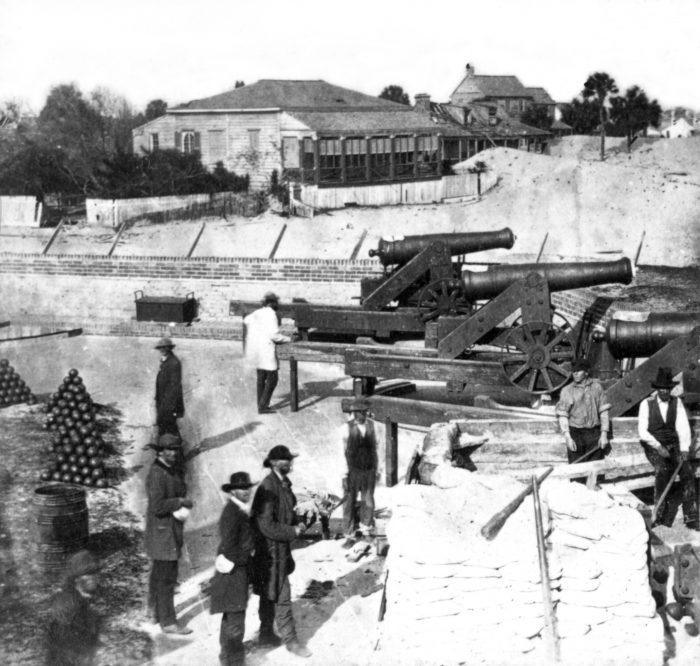
Cedar Hill Cemetery is located in Port Jefferson on a commanding site high above the village’s downtown and harbor.
Among those at rest in the cemetery, there are over 40 soldiers and sailors who served with the North during the Civil War.
Capt. C. A. Scanlan is also buried in the cemetery, but he fought against the Union forces in the South’s Lost Cause. His tombstone is inscribed with “C.S.A.,” the initials representing the Confederate States of America.
Who was this former Rebel officer and how did he become one of Port Jefferson’s permanent residents?
Charles Anthony Scanlan was born in Beaufort, South Carolina, in 1825. Married twice, he had a daughter with his first wife.
Scanlan worked as a shipsmith on the docks in Charleston, South Carolina, worshipped at the city’s First Baptist Church, was a Freemason, and belonged to the local militia.
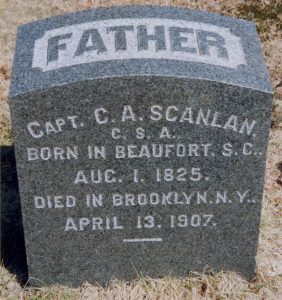
Photo by Kenneth C. Brady
After South Carolina seceded from the Union, Federal troops transferred from the garrison at Fort Moultrie to the stronger Fort Sumter, both part of Charleston’s harbor defenses. Scanlan was among the Carolinians who then occupied the abandoned Fort Moultrie.
Scanlan began his duties at the emplacement on Jan. 1, 1861, served as an acting military storekeeper and readied the stronghold’s guns and ordinance for what would become the bombardment of Fort Sumter.
The action began on April 12, 1861, when a ring of Confederate batteries around Charleston Harbor hammered Fort Sumter, the barrage announcing the start of the Civil War. Described as a “sergeant” in a later account of the assault, Scanlan led a detachment of six men in Fort Moultrie’s magazine, one of the emplacements blasting the Union forces
Following the evacuation of the Federal garrison at Fort Sumter, Scanlan was assigned to Fort Walker on South Carolina’s Hilton Head Island. In official accounts of the battle, Scanlan was identified as a “lieutenant” and commended for his work in the citadel’s magazine.
After tours at South Carolina’s Castle Pinckney and Fort Beauregard, Scanlan was assigned to Fort Sumter, where he was wounded in August 1863 during the Union’s bombardment of the Confederate stronghold.
Scanlan ended his days in the military as a captain. He returned to Charleston where he resumed his work as a shipsmith, later pursuing an entirely new career.
Phosphate rocks, which existed in large quantities near Charleston, were used in the manufacture of commercial fertilizer. Scanlan fabricated machinery that improved the dredging of the valuable rock from South Carolina’s riverbeds. Securing patents on his inventions in 1877 and 1883, Scanlan profited handsomely from the extensive phosphate digging in the Ashley River region.
During the mining operations, fossils were found in the phosphate deposits. Fascinated with natural history, Scanlan began gathering the specimens, amassing the largest private collection of fossils in South Carolina and among the largest in the nation.
Following the death of his second wife Eliza in 1890, Scanlan moved to Port Jefferson to live with his daughter Mary Estelle who had married Henry Randall, a prominent Port Jefferson businessman and banker.
The Randalls spent summers at their house on Port Jefferson’s Myrtle Avenue and winters at their home in Brooklyn, with the elder Scanlan joining in the seasonal move.
Scanlan quickly became well-known in Port Jefferson. In 1893, he exhibited portions of his fossil collection at the village’s Athena Hall (Theatre Three) and later in many of Port Jefferson’s storefronts.
But two events brought Scanlan even wider acclaim. His fossils were displayed at the Brooklyn Institute of Arts and Sciences and at the Agricultural Palace during the Charleston Exposition, both shows earning Scanlan rave reviews for his superb collection.
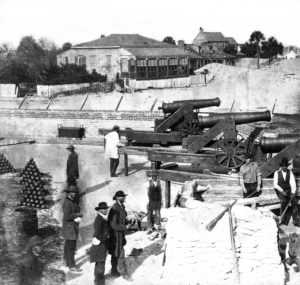
Besides providing his fossils for public viewing, Scanlan donated items from his collection to universities and museums in the United States and abroad, where paleontologists used the specimens in their studies of early forms of life.
Growing older, Scanlan reflected on his years in the military, thinking that at the time of the Civil War he had been “in the right” to support disunion, but later coming to believe he had fought in a “mistaken cause.”
Although he had once worn Confederate Gray, Scanlan was treated respectfully in Port Jefferson by his former foes. During Decoration Day ceremonies at Cedar Hill Cemetery in May 1905, he was among those honored by Lewis O. Conklin Post 627, Grand Army of the Republic (GAR), a Union veteran organization with a “camp” in the village.
Scanlan died in Brooklyn in 1907. Following Baptist services held at his son-in-law’s Port Jefferson home, Scanlan was buried at Cedar Hill Cemetery.
In 1913, Scanlan’s massive collection of fossils, amounting to over nine barrels of diggings, was sold by his estate to Connecticut’s Yale Peabody Museum of Natural History where Scanlan’s legacy lives on.
Kenneth Brady has served as the Port Jefferson Village Historian and president of the Port Jefferson Conservancy, as s well as on the boards of the Suffolk County Historical Society, Greater Port Jefferson Arts Council and Port Jefferson Historical Society. He is a longtime resident of Port Jefferson.


















